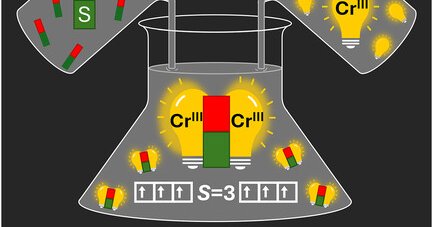
Cui Wang
@_CuiWang
Followers
333
Following
478
Media
8
Statuses
185
Assistent professor (TT) @University of Konstanz
Konstanz, Germany
Joined June 2013
New molecular design absorbs 2 photons to store 2 positive and 2 negative charges 100 ns lifetime, 3 eV energy storage, and 37% quantum yield A step toward multi-electron photochemistry Mathis Brändlin and @BjornPfund in @NatureChemistry
https://t.co/CwtRDeoRY3
4
46
246
Bite angle optimization weakens ligand fields in cobalt(III) complexes, yet lifetimes can increase due to rigidification pi-donor ligand properties are key New insights by @PolinaYaltseva in @J_A_C_S
https://t.co/AJRUjuV26U
pubs.acs.org
CoIII complexes have recently become an important focus in photophysics and photoredox catalysis due to metal-centered excited states with strong oxidizing properties. Optimizing chelate ligand bite...
1
23
168
Rethinking Iron Photoredox Catalysis For Fe(III) complexes, excited-state redox potentials don’t follow the usual rules - standard estimation methods fall short @JoelWellauer with Paul Francis & colleagues at @Deakin in @J_A_C_S
https://t.co/fF0q3RkFJO
pubs.acs.org
The reduction potentials of electronically excited states are crucial input values for photoredox reaction design. Since they are not directly measurable, they are typically estimated from the...
3
31
162
Unbelievable milestone for our group with a new publication in the prestigious @ACSCentSci ! Electron transfer, not energy transfer is controlling population of the final triplet state in a Fe(III)-PhAn dyad! @CadraLab @Gio_Ben_ @frsFNRS @WELRI_asbl
pubs.acs.org
An iron-anthracene dyad was recently used to populate a microsecond-lived nonluminescent (dark) triplet state, but with a surprisingly low triplet population yield. In-depth spectroscopic experiments...
3
11
68
Happy to share our latest publication with @Irialized published in @J_A_C_S: Understanding Anomalous Cage-Escape Dynamics in Photoredox Processes Driven by a Fe(III) N-Heterocyclic Carbene Complex | Journal of the American Chemical Society
pubs.acs.org
Solvent cage-escape dynamics of bimolecular photoredox products in solution has been investigated computationally through a combination of molecular dynamics simulations and quantum chemical calcul...
2
15
47
Organic molecules can have multiple photo-accessible spin manifolds? In our paper in @NatureChemistry we show how you can read and write spin-dependent information in a unique organic molecule using photons! https://t.co/U0zdNJDGHe Next up: Room Temperature control!😉
nature.com
Nature Chemistry - Controlling electron spin states with light is vital for quantum technologies but requires electronic excitations with net spin. Now a molecular diradical with two trityl radical...
8
9
96
Cr(III) complexes with enhanced metal–ligand covalency enable tunable NIR luminescence and endergonic red-light photoreduction. @GiacomoMorsell2 and team find signs of doublet–doublet annihilation, or excited-state disproportionation. Now in @J_A_C_S: https://t.co/0ckIcD4Ppu
pubs.acs.org
Photoactive CrIII complexes are typically based on polypyridine coordination environments, exhibit red luminescence, and are good photo-oxidants but have modest photoreducing properties. We report...
4
25
194
Check out our new paper on TTA photon upconversion toward UVC energy generation using TIPS‐benzene as an emitter and heptazine as a sensitizer in Adv Opt Mater @AdvPortfolio. Nice collaboration with @Naoya_Aizawa. Congrats Masanori! https://t.co/c1G1g1FANz
4
11
116
Thrilled to share our new JACS paper on anti-Kasha photoreactivity! We show that higher-lying excited states can drive electron transfer — opening new doors for photoredox catalysis. Huge thanks to @WengerOliver for the incredible mentorship! https://t.co/6ev230GD6v
pubs.acs.org
Nearly all photochemical transformations known to date follow Kasha’s rule, implying that reactions occur only from the lowest electronically excited state of a given spin multiplicity due to the...
5
7
58
We show how photoredox catalysis can bypass Kasha’s rule, enabling reactions from higher excited states. This work, led by the exceptional @BjornPfund, offers new insights into photochemical reactivity. Published in @J_A_C_S: https://t.co/4waiPatQKZ
3
35
205
Our review article about "Photon upconversion sensitized by earth-abundant transition metal complexes", is now online! https://t.co/8sAIHv0fwg
3
3
28
#ChemPhotoChem Luminescent Dinuclear Chromium(III) Complexes with Ferromagnetic Exchange Interactions (Cui Wang and co-workers) •
chemistry-europe.onlinelibrary.wiley.com
Highly luminescent CrIII complexes require large ligand field splitting and nearly perfect octahedral geometry. Ferromagnetically coupled dinuclear CrIII complexes rely on the interplay of the...
0
3
6
Happy to share that our Concept for designing luminescent chromium(III) dimers with ferromagnetic coupling is published on @ChemPhotoChem , congrats to Dennis!
chemistry-europe.onlinelibrary.wiley.com
Highly luminescent CrIII complexes require large ligand field splitting and nearly perfect octahedral geometry. Ferromagnetically coupled dinuclear CrIII complexes rely on the interplay of the...
2
3
28
A simple guide to the design of metal complexes in luminescence and photoredox catalysis. With @GiacomoMorsell2 and @reber_christian in @J_A_C_S: https://t.co/7IYSYtL1SS
pubs.acs.org
Luminescence and photochemistry involve electronically excited states that are inherently unstable and therefore spontaneously decay to electronic ground states, in most cases by nonradiative energy...
2
59
249
Microsecond Dark Excited-State Lifetime and Large Cage Escape Yield Afforded by an Iron–Anthracene Molecular Dyad! Electron and energy transfer become accessible! Check out our latest work, spearheaded by the great Felix and Simon! Out in @J_A_C_S now!
pubs.acs.org
Iron photosensitizers represent a holy grail in photochemistry, but their widespread implementation is limited by their short excited-state lifetimes and poor cage escape yields. Here, the introduc...
6
14
80
Iron(III) complexes with luminescence lifetimes of up to 100 nanoseconds to enhance upconversion and photocatalysis Published in @J_A_C_S, Joel Wellauer and @BjornPfund in collaboration with @AKMeyer_Goe
https://t.co/repdAon6wf
pubs.acs.org
Iron is the most abundant transition metal element and would be the ideal replacement for noble metals in many applications that rely on luminescent and long-lived electronically excited states. We...
11
38
262
New insights on the modulation of the spin-flip transition in chromium(III) complexes. Congrats to Yating Ye and all co-authors. Great collaboration #PiguetGroup @WengerOliver @CanalUGR @ChemicalScience
https://t.co/3MemO3qa48
pubs.rsc.org
Three homoleptic spin–flip (SF) emitters, namely [Cr(Mebipzp)2]3+ (1), [Cr(IMebipzp)2]3+ (2) and [Cr(bip*)2]3+ (3), have been successfully synthesized and characterized. The weak distortion compared...
3
7
40
Very proud to see my first last-author paper published! We report dramatic effects of a ligand backbone modification on 3MLCT lifetimes in Cr/Mo/W complexes. Read how we disentangle potential energy well flattening, conformations and self-quenching!
pubs.acs.org
We recently reported a molecular design for carbonylpyridine molybdenum(0) complexes that unlocks long-lived luminescent and photoactive charge-transfer states. Here, we translate this strategy to...
A Blessing and a Curse: Remote Ligand Functionalization Modulates 3MLCT Relaxation in Group 6 Tricarbonyl Complexes https://t.co/sFGyzMtVcQ
@winald_kitzmann @LabHeinze and co-workers @InorgChem #chromium #molybdenum #tungsten #carbonylpyridine #3MLCT #flattening #spacer
3
4
58
Luminescent Cerium(III) Complexes with Poly(mercaptoimidazolyl)borate: A New Emitter Based on S-Coordinating Ligands | Journal of the American Chemical Society
pubs.acs.org
Lanthanide ions are hard Lewis acids and usually form weak bonds with soft sulfur donors, which result in the supposed instability of their complexes with S-coordinating ligands. Compared with...
1
15
72
Check out @WengerOliver and my perspective delving into the role of organic radicals in photoredox catalysis: from catalysis and mechanistic studies to (sub)-picosecond reactivity and the potential of anti-Kasha reactivity! https://t.co/6am3sN7hFL
pubs.acs.org
Many important synthetic-oriented works have proposed excited organic radicals as photoactive species, yet mechanistic studies raised doubts about whether they can truly function as photocatalysts....
3
12
53
























